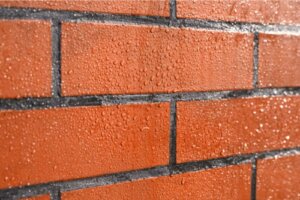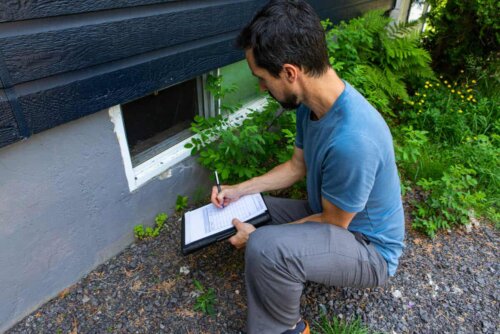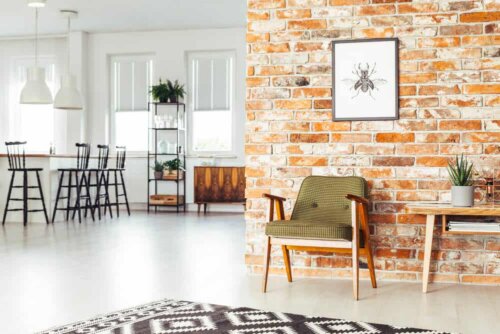How to Protect Brick Walls From Mold

Mold is a fungus that easily grows in areas where there’s a lot of humidity and darkness. You can find it both inside and outside and it’s one of the issues that most affect the tranquility and aesthetics of a home. Discover how to protect your brick walls in this article!
A little about mold
Fungi generate spores to reproduce. Thus, it doesn’t require fertilization. These spores float in the air and aren’t visible to the naked eye. For that reason, they circulate in the environment until they generate new colonies in multiple sectors of the house.
It’s easy to detect when mold is forming because it leaves a green, grey, or white stain. The fungi are harmful inside because they retain humidity and can crack walls. Also, they can affect our health, causing respiratory illnesses and irritating the eyes.
Materials to protect your brick walls
Harsh climates and drastic temperature changes can cause mold to form on brick walls. For that reason, with the slightest neglect, any house can be the victim of one of the most notorious and uncomfortable fungi.
However, with some cheap and easy-to-find materials, you can remove what’s stuck to the bricks of your home. Below, we detail the necessary steps you can take to treat this inconvenience.
Face masks and gloves
To do the cleaning process and protect your brick walls from mold, you’ll need to use suitable protection. This is because direct contact with the mold can cause skin erosions, nasal allergies, and irritations in your respiratory tract.
Similarly, protection is also important because when using cleaning products, people with sensitive skin may experience adverse reactions to their skin.

White vinegar
This is the liquid solution many specialists recommend to clean the surfaces where mold has accumulated. This is because vinegar contains properties that kill microorganisms, clear away stains, and remove any unpleasant odors.
You should use the vinegar without diluting it as your intention here is to apply a potent liquid. Also, it’s a good idea to use a sprayer that will help you spritz every one of the zones that the mold affects, and helps you to avoid wasting the product.
Keep reading: Is it Safe to Remove Mold From Food and Eat the Rest?
Toilet brush and pressure hose
During the cleaning process, you’ll need to use a cleaning brush. This tool will help distribute the liquid solution, work the zones that are difficult to access, and remove the most stubbornly stuck mold on the brick walls.
Also, using a pressure hose will make the rinsing phases easier and help to weaken the most complicated residue to remove.
Hot water
The water you use during the cleaning process should be hot because it’s the best temperature for removing dirt, fat, toxins, and built-up microorganisms.
Steps to protect your brick walls from mold
With 6 simple steps, you can achieve a brick wall that is permanently free from mold, whilst keeping it looking good and healthy. Below we tell you the necessary steps to get a successful cleaning process.
1. Inspect the area
Just like with any process, it’s essential to take your time to analyze every one of the zones that you’re going to be working on. This step allows you to examine the surface, discover if there are imperfections, and consult a specialist if there’s any piping damage that’s causing the humidity.
If you skip this phase, the mold stains may persist on your brick walls and become noticeable again in a few days.
2. Wear protective clothing
Before getting started with the cleaning process, you should make sure you’re wearing a face mask and gloves that have been designed for such work.
You must use protection until the final process to preventd any health problems. Also, you should make sure that the clothing you buy is of good quality to guarantee your safety.
3. Clean the brick wall
To get started on removing the mold, it’s necessary to clean each sector of the wall with water. This step is key in eliminating the different kinds of dirt that accumulate.
The area should be free of all kinds of dust that could trigger any future reproduction of microorganisms. For that reason, it’s essential that disinfect it with hot water at the first step.
4. Apply white vinegar
You should put the white vinegar in a container that is in a good state and has a spray top. After spritzing all of the affected areas well, let it sit for 15 minutes so that the solution starts to act on the bits between the bricks.
5. Scrub with a brush
You should give all the bricks a good scrub to make sure you properly distribute the vinegar on the wall and remove all the mold that’s still stuck. With this tool, you can polish the details until you’ve got an impeccable surface.
6. Rinse and add a little more of the liquid solution
Finally, it’s important to rinse the whole wall with hot water. This way, you’re able to remove the rest of the mold that you’ve scrubbed off with the brush.
In addition to that, you should spray vinegar in the most affected areas to reduce stains and avoid bad smells.
7. You should clean brick walls often
This kind of cleaning has to be part of your general house cleaning routine. This step helps to guarantee that your wall stays protected from humidity and mold.
Recommendations to prevent mold on your brick walls
Your home should stay well-ventilated to ensure it’s at a stable temperature. Opening the windows and the doors is essential to ensure a purifying air enters that helps to clean the area and removes the accumulation of vapor.
Also, you can keep plants that absorb toxins and balance the area.
You should regularly clean all your surfaces. This ensures that your home is free from infections and clumps of dirt.
Also, in areas like the bathroom and kitchen, you should have an adequate drainage system so that the water you use day to day doesn’t stay stuck in the pipes and cause damage.
Quality constructions are essential as they use materials that counteract the presence of harmful microorganisms.

Discover: 5 Tips to Clean Your Bathroom Curtains and Keep Them Mold Free
Hygiene and light to protect your brick walls from mold
Having good hygiene helps you keep your space in good condition. For that reason, you shouldn’t wait until fungi appear to do the important maintenance on the walls.
Cleaning the bricks is efficient with natural products. With that in mind, we recommend you take a look at the benefits of vinegar and avoid using detergents that contain a high level of chemicals.
To summarize, opening the windows is something that you shouldn’t forget to do regularly. This will allow the necessary light and air to enter so that the fungi stay far away from your home!
All cited sources were thoroughly reviewed by our team to ensure their quality, reliability, currency, and validity. The bibliography of this article was considered reliable and of academic or scientific accuracy.
- EPA. Una breve guía para el moho, la humedad y su hogar [Internet]. Washington: U.S. Environmental Protection Agency; (S.F) [citado 06 de abril de 2021]
- Departamento de salud y salud mental de la ciudad de Nueva York. Pautas para la evaluación y la eliminación de hongos en ambientes interiores [Internet]. New York: Unidad de Epidemiología Ambiental y Ocupaciones del Departamento de Salud y Salud Mental de la Ciudad de Nueva York; 2010 [citado 06 de abril de 2021]
- Torres J. Hongos y patología respiratoria en nuestro medio [Internet]. Barcelona: Universitat Autónoma de Barcelona; 1988 [citado 06 de abril de 2021]
- Garcés E. Correa M. Coba B. Orozco M. Zapata A. Anacona A. Sabogal S. Morfología y clasificación de los hongos [Internet]. Colombia: Departamento de Biología de la Universidad Nacional de Colombia; (S.F) [citado 06 de abril de 2021]
This text is provided for informational purposes only and does not replace consultation with a professional. If in doubt, consult your specialist.








